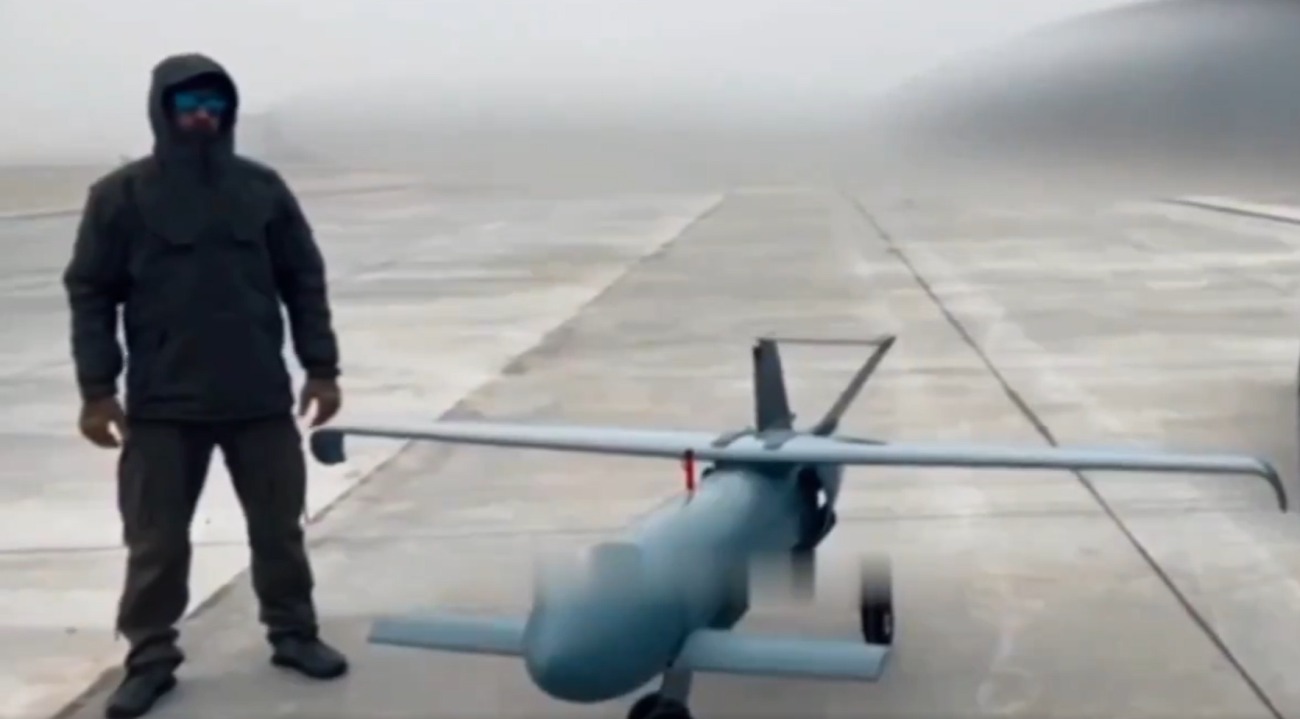A video has appeared on social media showing flight operations of a jet-powered Ukrainian drone, believed to be the Palyanitsya drone missile that Zelensky recently claimed had been used in combat for the first time.
The video shows a stubby cigar-shaped drone, approximately 2m long, positioned on a runway threshold and fitted with a discardable tricycle undercarriage. The drone, featuring canard foreplanes and twin large angled fins, is then fitted with straight wings of approximately 3m span.
The drone is powered by a single engine fitted at the rear, with twin recessed air intakes on the side of the rear fuselage. Air intake shaping is aimed at stealth and avoiding ground debris ingestion during takeoff. Going by the appearance of the exhaust, the engine could be a Pulsejet.
A pulsejet operates by igniting fuel in pulses, creating a series of rapid explosions that produce thrust. This design is simple and typically has few or no moving parts. Pulse jets have higher fuel consumption than turbojets, but the simplicity of the design reduces weight and leaves space in the fuselage to carry more fuel.
https://t.co/DVyHL9xvd5
Footage of test of a new 🇺🇦jet powered drone have been published.Believed to be the "Palantsiya" drone that Zelensky announced yesterday pic.twitter.com/XycwEjjfk3
— Tony (@Cyberspec1) August 25, 2024
Going by the sound of the engine, it could also be a traditional turbojet.
The drone is shown rolling for take-off, gaining speed, discarding its undercarriage, and getting airborne. Subsequent visuals show the drone making a pass over the runway, flying as low as around 10m.
Later, the drone is shown being serviced on the runway threshold. It is taken to full power while being held stationary using a single-handed palm grip on the nose cone.
Analysis
The thrust of the engine is obviously limited, pointing to a low-weight drone.
The use of discardable undercarriage and the absence of hardpoints on the wing or fuselage suggest a kamikaze drone fitted with a warhead inside the fuselage. Indeed, it’s possible that at around 10s into the footage, the drone warhead is shown being armed.
The Palyanytsia is designed as a high-speed, precision-targeted projectile. It combines the capabilities of a drone and a missile, making it a versatile weapon for both reconnaissance and strike missions.
While a missile flies and strikes its target autonomously, a drone can be remotely piloted.
What Makes The Palyanytsia Potent
Remote piloting gives critical advantages over autonomous piloting. We dwelt on the reasons in an earlier analysis here.
The remote pilot can fly the drone at much lower heights to avoid radar detection and engagement by air defense (AD) systems and strike targets with much greater precision.

Ukraine has successfully leveraged the advantages of remote piloting using bulky, non-stealthy, slow-flying piston-engined drones such as the UJ-22 and A22. These drones can operate in both remotely piloted and autonomous modes. Autonomous mode is generally used only for pre-programmed reconnaissance missions.
When used for strike missions, the drones are remotely piloted, facilitating better radar avoidance and more precise targeting.
Radar detection is most effectively avoided, not by stealth design but by flying lower than the radar horizon. To follow a more effective nap-of-the-earth (NOE) profile that minimizes the chances of radar detection, the Ukrainian drones visually avoid terrain. The remote pilot can see what lies ahead—high-tension cables, high ground, or buildings—and alter the drone’s flight path.
In contrast, autonomous terrain avoidance needs to account for navigational errors. As a result, cruise missiles generally fly much higher than they need to avoid terrain that they could crash into if they drift off track because of strong winds or navigational errors. As a result, cruise missiles end up being more prone to radar detection than larger, unstealthy drones.
Remote piloting also allows the pilot to positively identify the target and choose the best mode (kamikaze or bomb drop) of attack, and the optimum terminal path and trajectory. The results can be spectacular as compared to the accuracy of cruise missile attacks.
The Ukrainian Advantage
Remote piloting is possible only if a drone can stay connected to its operator. Satellite-based communication can allow a drone to remain connected with its operator, but satellite communication can be easily jammed by the adversary, something the Russians are particularly good at doing.
Ukraine has the perfect solution—Elon Musk’s Starlink communication satellite constellation. The constellation’s large number of satellites and physical spread make effective jamming difficult because of the redundancy provided by alternative communication pathways.
Russia doesn’t have a communication satellite constellation like the Starlink. It’s forced to rely on traditional satellite communication in which a large geographical area is covered by just one or two communication satellites, facilitating easy jamming.
Without a Starlink analog, Russia cannot use remotely piloted drones for attacks on Ukraine. It’s forced to rely on autonomous cruise missiles such as the 3M-14 Kalibre and the Kh-101.
Flying in autonomous mode, these missiles rely on a programmed flight profile that adjusts cruising altitude to the expected terrain below to avoid crashing into terrain.
The missiles are forced to fly at much greater heights than they need to, thereby exposing them to early radar detection and AD missile engagement.
The Russian Kalibr 3M-14 Cruise Missile, for example, is much smaller than a UJ-22 drone. It has a much stealthier design and flies almost seven times the speed of the drone.
Yet, statistics released by the General Staff of Ukraine on the effectiveness of its air defense indicate that the penetration rate of the Kaiber is just 50%. The penetration rate of the even stealthier Russian Kh-101 missile is worse, at around 30%!
Palyanytsia Limitations
The drone shown in the video is relatively small. In contrast to the 6.2m length of the Kalibr 3M-14 Cruise Missile, the Palyanytsia is just around 2m.
Ukrainian sources have claimed that the Palyanytsia is a long-range drone. However, even if it has a traditional turbojet engine, this is unlikely.
Conclusion
A strike drone equipped with a jet engine is more difficult to intercept because of its higher speed and more lethal because of its higher kinetic energy at the time of the target strike. Remote piloting makes the drone less susceptible to adversary interception and facilitates more accurate delivery of warheads.
This new class of weapons represents an advancement in Ukraine’s military capabilities.
Video link: https://x.com/Cyberspec1/status/1827504456948424824




